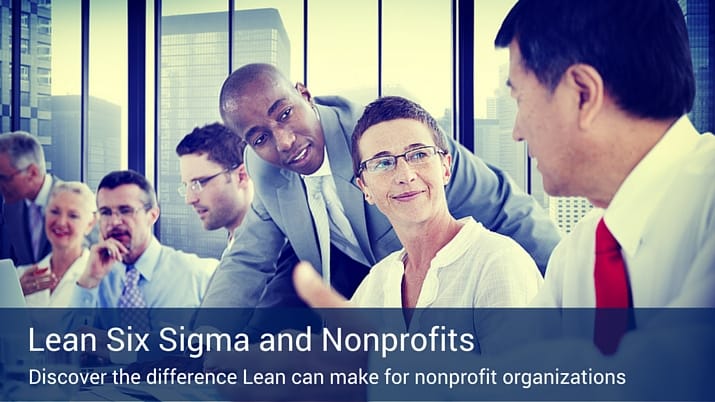How Lean Six Sigma Benefits Nonprofit Organizations

Last Updated June 30, 2015
Most organizations face certain challenges when adopting the Lean Six Sigma methodology. The first obstacle that many nonprofits encounter is the belief that Lean Six Sigma principles simply don’t apply to them. Fortunately, this is an inaccuracy.
Why Nonprofits Need Lean Six Sigma
The myth that only manufacturing firms benefit from Lean Six Sigma has been disproven time and time again but still lingers. Your organization doesn’t need a factory, a warehouse or a complicated manufacturing process to experience the benefits of Lean Six Sigma.
Any organization that uses a repeatable process can apply Lean Six Sigma to become more efficient and productive. Nonprofit organizations routinely use repeatable processes that could be streamlined and improved with Lean Six Sigma, such as:
- Updating and managing client case files
- Caring for and feeding animals in a shelter
- Mobilizing resources for disaster relief
- Deploying community educational programs
- Maintaining financial records and budgets
The Right State of Mind
A second obstacle standing in the way of nonprofits looking to practice Lean Six Sigma is the establishment’s organizational culture. Nonprofits tend to attract employees that are loyal and devoted to the people and causes they support. These loyal and dedicated employees can help to create a dynamic and driven organization. But a vision that is too tightly focused on clients and principles can also lead to an environment where the efficiencies that Lean Six Sigma creates are given a low priority.
Nonprofit employees are right to make improving the lives of people and promoting a worthy cause their highest priority. However, they must also acknowledge that the efficiency and savings that Lean Six Sigma creates can help them do more good and impact more people with the resources at their disposal. When employees understand that creating efficient processes can advance their mission, they may be more willing to accept the Lean Six Sigma methodology.
Practicing Lean Six Sigma
There’s no one right way to deploy Lean Six Sigma. Different nonprofit organizations might require different degrees of continuous improvement. Start by analyzing the organization, its mission and its objectives. This includes developing a clear picture of the end clients, what they expect of the nonprofit and how well their needs are currently being served. Lean Six Sigma calls this obtaining the voice of the customer.
Aligning Lean Six Sigma improvement efforts with the voice of the customer helps ensure that your team will make a difference where it matters most to the customer.
The Difference Lean Six Sigma Can Make for Nonprofits
Increased Efficiency — Nonprofits are legendary for their ability to operate with meager budgets and small staffs. Therefore, when Lean Six Sigma improvements help a nonprofit do more work with the same amount of people and resources, the gains have an even greater impact than they would in a corporate setting.
Improved Customer Service — Lean Six Sigma also yields measurable benefits where it matters most to nonprofits, helping more clients. A streamlined filing system can help caseworkers spend less time processing paperwork and give them more time to lead projects and work directly with clients. Animal shelters that simplify pet adoption programs, for instance, can place more pets into better homes.
Lean Six Sigma can be a powerful force for helping nonprofits do more of the good they were founded to do. For information about how you and your team can learn more about Lean Six Sigma from Villanova University, click on the button below, or call today at (855) 300-1473.





